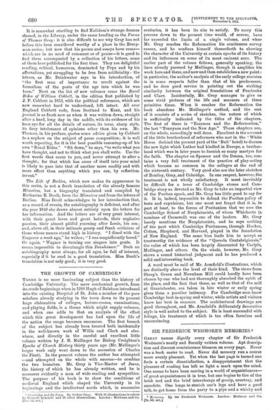THE GROWTH OF CAMBRIDGE.* THESE is no more fascinating subject
than the history of Cambridge University. The mere mechanical growth, from its crude beginnings when in 1280 Hugh of Balsham introduced into the existing Hospital of St. John a number of the poor scholars already studying in the town down to its present huge elaboration of colleges, lecture-rooms, examinations, and playing fields, is a theme which might supply volumes, and when one adds to that an analysis of the effect which this great development has had upon the life of the nation the range becomes enormous. The first branch of the subject has already been treated both incidentally in the well-known work of Willis and Clark and else- where, and directly in the careful and excellent little volume written by J. B. Mullinger for Bishop Creighton's Epochs of Church History thirty years ago (Mr. Mullinger's larger work only went down to the accession of Charles the First). In the present volume the author has attempted —and attempted on the whole with success—to combine the two branches. Mr. Gray is Vice-Master of Jesus, the history of which he has already written, and he is moreover evidently a man of wide reading and sympathies. The purpose of his book is to show the conditions of medieval England which shaped the University in its beginnings and the intellectual needs which, in successive
• Cambridge and Its Story. By Arthur Gray. With 16 illustrations in colour by Maxwell Arinfield and 16 other illustrations. London : Methuen and Co. [Os. td. net.]
centuries, it has been its aim to satisfy. To carry this process down to the present time would, of course, have far exceeded the limits of a single volume, and when Mr. Gray reaches the Reformation his continuous survey ceases, and he confines himself thenceforth to showing the character of the University at certain epochs of its history and its influences on some of its most eminent sons. The earlier part of the volume follows, generally speaking, the lines already pursued by Mullinger, though it amplifies his work here and there, and now and then establishes a new point : in particular, the author's analysis of the early college statutes is in some respects fuller than that of his predecessor, and he does good service in pointing out the striking similarity between the original foundations of Pembroke and Clare. Incidentally, Mr. Gray manages to give us some vivid pictures of the life and manners of these primitive times. When it reaches the Reformation the book abandons Mr. Mullinger's method, and the rest of it consists of a series of sketches, the nature of which is sufficiently indicated by the titles of the chapters. The first of these is "Erasmus and the Reformation," the last "Tennyson and the New Age." These chapters are, on the whole, exceedingly well done. Excellent is the account of the little brotherhood of reformers who met in the White Horse (behind the present yard of the Bull' hotel) to discuss the new light which Luther had kindled in Europe, a brother- hood which was in later years to furnish so many martyrs for the faith. The chapter on Spenser and the Drama, too, con- tains a very full treatment of the practice of play-acting which became so common in the colleges at the end of the sixteenth century. Very good also are the later sketches of Bentley, Gray, and Coleridge. In one respect, however, the treatment is not wholly satisfactory. It must inevitably be difficult for a lover of Cambridge stones and Cam- bridge story as devoted as Mr. Gray to take an impartial view of the Puritan epoch, and Mr. Gray has little good to say for it. It is, indeed, impossible to defend the Puritan policy of tests and expulsions, but one must not forget that it is, in part at least, to the forces of Puritanism that we owe the Cambridge School of Neoplatonists, of whom Whichcote nominee of Cromwell) was one of the leaders. Mr. Gray barely mentions the Neoplatonists, and be says nothing of the part which Cambridge Puritanism, through Hooker, Cotton, Shephard, and Harvard, played in the foundation of New England. The same bias leads him to accept as trustworthy the evidence of the " Querela Cantabrigiensis," the value of which has been largely discounted by Carlyle, Mullinger, and others. On the whole, however, Mr. Gray shows a sound historical judgment and he has produced a solid and interesting book.
A word must be said of Mr. Armfield's illustrations, which are distinctly above the level of their kind. The views from Sheep's Green and Newnham Mill could hardly have been chosen by one who bad not thoroughly absorbed the spirit of the place, and the fact that these, as well as that of the mill at Gra.ntchester, are taken in late winter or early spring gives them a peculiar intimacy. For Cambridge men know Cambridge best in spring and winter, while artists and visitors know her best in summer. The architectural drawings are good throughout, and Mr. Armfield's deliberately decorative style is well suited to the subject. He is least successful with foliage, his treatment of which is too often formless and unconvincing.


























































 Previous page
Previous page